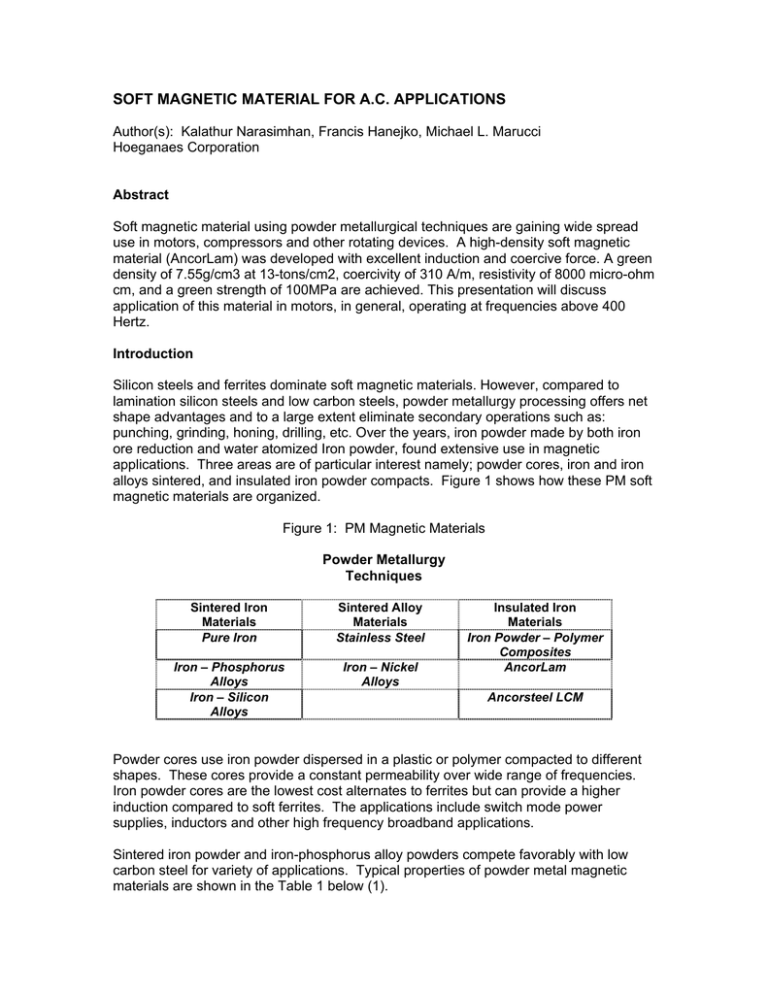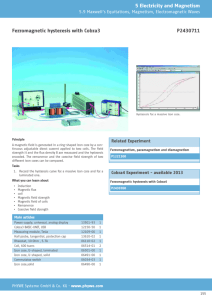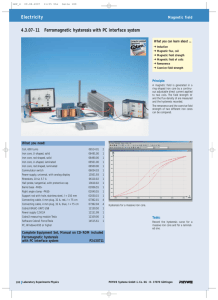SOFT MAGNETIC MATERIAL FOR A.C. APPLICATIONS
advertisement

SOFT MAGNETIC MATERIAL FOR A.C. APPLICATIONS Author(s): Kalathur Narasimhan, Francis Hanejko, Michael L. Marucci Hoeganaes Corporation Abstract Soft magnetic material using powder metallurgical techniques are gaining wide spread use in motors, compressors and other rotating devices. A high-density soft magnetic material (AncorLam) was developed with excellent induction and coercive force. A green density of 7.55g/cm3 at 13-tons/cm2, coercivity of 310 A/m, resistivity of 8000 micro-ohm cm, and a green strength of 100MPa are achieved. This presentation will discuss application of this material in motors, in general, operating at frequencies above 400 Hertz. Introduction Silicon steels and ferrites dominate soft magnetic materials. However, compared to lamination silicon steels and low carbon steels, powder metallurgy processing offers net shape advantages and to a large extent eliminate secondary operations such as: punching, grinding, honing, drilling, etc. Over the years, iron powder made by both iron ore reduction and water atomized Iron powder, found extensive use in magnetic applications. Three areas are of particular interest namely; powder cores, iron and iron alloys sintered, and insulated iron powder compacts. Figure 1 shows how these PM soft magnetic materials are organized. Figure 1: PM Magnetic Materials Powder Metallurgy Techniques Sintered Iron Materials Pure Iron Sintered Alloy Materials Stainless Steel Iron – Phosphorus Alloys Iron – Silicon Alloys Iron – Nickel Alloys Insulated Iron Materials Iron Powder – Polymer Composites AncorLam Ancorsteel LCM Powder cores use iron powder dispersed in a plastic or polymer compacted to different shapes. These cores provide a constant permeability over wide range of frequencies. Iron powder cores are the lowest cost alternates to ferrites but can provide a higher induction compared to soft ferrites. The applications include switch mode power supplies, inductors and other high frequency broadband applications. Sintered iron powder and iron-phosphorus alloy powders compete favorably with low carbon steel for variety of applications. Typical properties of powder metal magnetic materials are shown in the Table 1 below (1). Table 1: Typical Properties of PM Magnetic Materials Alloy System Typical Density (g/cm3) Fe 6.8/7.2 Fe-P 6.7/7.4 Fe-Si 6.8 400SS 5.9/6.5 50Ni/50Fe 7.2/7.6 Approx. Relative Cost 1 1.2 1.4 3.5 10 µmax Hc (kA/m) Bmax (T) Resistivity (µΩ-cm) 1800/3500 2500/6000 2000/5000 500/1000 5000/15000 0.12 – 0.2 0.10 – 0.16 0.02 – 0.08 0.12 – 0.24 0.01 – 0.04 1.0/1.3 1.0/1.4 0.8/1.1 0.6/0.8 0.9/1.4 10 30 60 50 45 Water atomized iron powders are used in making magnetic parts for use in flux return paths, sensors, magnetic solenoids and plungers. These traditional DC applications require sintering of the compacted parts in a hydrogen or a dissociated ammonia atmosphere. Table 2 lists the typical magnetic properties that can be achieved. Table 2: Typical magnetic properties of iron powder sintered at various temperatures. Sintering Compaction Sintered Hc Temp. Pressure Density (kA/m) (ºC) (MPa) 410 6.82 0.23 1120 550 7.14 0.23 Pure 690 7.30 0.23 Iron Powder 410 6.86 0.21 1260 550 7.14 0.21 690 7.32 0.21 Material* B @119 A/m (T) Bmax (T) µmax 0.73 0.85 0.92 0.75 0.86 0.93 1.06 1.21 1.29 1.10 1.24 1.32 2530 3070 3340 2730 3190 3570 * All data measured at an applied field of 15 Oe (119 A/m) For applications that require higher resistivity and higher induction, iron-phosphorus alloys are extensively used. The amount of phosphorus used is typically 0.45%, although in some cases 0.80% P is used. Phosphorus helps in reducing the coercive force and increasing the density that can be achieved. Phosphorus additions also improve the mechanical properties of the material, such as yield and tensile strength along with tensile elongation. A process called “ANCORDENSE”, also referred to as warm compaction, achieved a major advancement in the sintered soft magnets. In this process iron powder and potentially ferro-phosphorus additions are combined with a unique lubricant system enabling compaction at temperatures of 135 ºC to 145 ºC. Sintered densities achieved are much higher than conventional compaction (2). Densities of 7.57 g/cm3 and maximum induction of 15,5000 Gauss (1.55T) were achieved. A variety of other powder metal sintered alloys are used, though to a lesser extent. Fe-Si, Ni-Mo, Fe-Si-Al are a few of the examples. AC Magnetic Applications When ferromagnetic materials are used in time-varying magnetic fields such as those found in alternating current (AC) applications, the effect of frequency on the behavior of the magnetic material must be taken into account. Measured permeability is affected by changes in frequency. Additionally, the “loss” associated with materials that are exposed to changing magnetic field must be considered. Core Loss An important factor to consider in the evaluation of a magnetic material in an AC application is core loss. Core loss is defined as the power dissipated in the core as it is exposed to alternating magnetic field. In general, core loss should be minimized by maximizing energy efficiency. Core loss can be expressed as the sum of hysteresis loss and eddy current loss. Hysteresis loss can be described as the energy needed to sweep the domain walls. As a material is exposed to an alternating magnetic field, each cycle around the hysteresis loop requires a certain amount of energy. That energy is directly related to the area swept out by the hysteresis loop. The hysteresis loss is dependent upon the frequency of the application and the hysteresis loop area of the material and can be expressed as follows: Hysteresis Loss = KH *Loop Area *ƒ (5) In which, KH is a constant and ƒ is the frequency of the varying magnetic field. Reducing the hysteresis loop area of the material decreases hysteresis loss. Generally, lowering the coercivity reduces hysteresis loop area. The other component of core loss is known as eddy current loss. When a ferromagnetic material is exposed to an alternating magnetic field, electrical currents are induced within the material. The magnitude of these currents, often referred to as eddy currents, depends upon the frequency of the applied magnetic field, the resistivity of the ferromagnetic material, the induction level, and the ease with which these currents can circulate through the material. The result of these currents is an increase in heat generation within the core material. The contribution of the total loss in the core due to eddy currents is typically referred to as eddy current loss. An expression for eddy current loss is shown in below: Eddy Current Loss = KE * [d2 * B2 * f2] / ρ (5) Where KE is a constant, d is the thickness of the material; B is the induction level, ƒ is the frequency and ρ is the electrical resistivity of the ferromagnetic material. As total core loss is measured over a wide frequency range, the contribution of each component of loss to the total core loss changes. Since hysteresis loss and eddy current loss are functions of frequency to the first and second power, respectively, hysteresis dominates the low frequency losses and eddy currents dominate the high frequency losses. Permeability Eddy currents also affect the measured permeability of a magnetic material that is exposed to varying magnetic field. Eddy currents circulate in such a way as to set up a magnetic field opposing the direction of the applied field. The larger the eddy currents; the higher the opposing magnetic field. The result is a lower net magnetic field actually acting on the core material. The lower net magnetic field produces a lower measured induction level. Since permeability is defined as follows: µ= B (5) H In order to reduce the eddy currents, lamination steels are rolled as thin sheets to increase the resistance and improve penetration depth of the magnetic field. Sintered powder material cannot be used in AC applications for optimum performance. Insulated Iron Powder It has been the desire of powder metallurgists to replace lamination steel with powder metal components. Lamination steels are punched to shape and are stacked and welded. Powder metal components can be made directly to shape in one single operation. The development of the powder metal process for replacing lamination steel was inspired by the fact that eddy current core loss can be confined to an individual particle in a compact as long as a coating electrically isolates these particles. Major application of these types of materials is in devices, such as motors, induction coil cores, actuators etc. Work at Hoeganaes on a technology such as this resulted in the development in iron polymer coated powders. (3.4). These powders required heating of the powder and the die to elevated temperatures. A coating process has been developed to individually coat iron powder particles, this new powder does not require heating of the powder for producing parts and also use moderate die temperatures. This powder is referred to as AncorLam™, or insulated iron powder. This newly developed insulated iron powder is compacted with heated dies at 93 0C. Densities as high as 7.5g/cm3 can be achieved at compaction pressures of 800MPa with resistivity exceeding 15,000 micro-Ohm cm. The green strength of these compacts approaches 100MPa depending on compaction pressure, at 800MPa a green strength of 100 MPa is achieved. Experimental Insulated iron powder is premixed with lubricants and compacted to 7.5g/cm3 to produce green toroids. The ratio of inner diameter to outer diameter is 0.67.The toroids produced are cured at 450 0C for one hour in a nitrogen atmosphere. The core properties were measured using a commercial magnetic Hysteresisgraph. The D.C portion complies with ASTM A773/773-M1 and A.C portion to ASTM A927/927-M99. Results and Discussion Figure 2 shows the hysteresis curve measured using D.C applied field. In Figure 3 a comparison is made of the hysteresis curves measured at various AC fields. The near complete superposition of the loops suggests very little contribution from the eddy current loss indicating good insulation of individual particles. 2.0 2.0 1.5 1.5 1.0 DC 0.5 Induction, T Induction, T 1.0 0.0 -100 -50 -0.5 0 50 100 0.5 0.0 -100 -50 0 -0.5 -1.0 -1.0 50 100 DC 60 Hz 100 Hz -1.5 -1.5 400 Hz -2.0 -2.0 Applied Field Applied Field Figure 2: D.C Hysteresis of Insulated iron powder pressed to a density of 7.5 g/cm3.(Applied field in Oe) Figure 3: Hysteresis Curves measured at various AC frequencies superposed on a DC hysteresis curve.(Applied Field in Oe) Saturation induction of the newly developed powder is as high as 1.9T. Core Loss 10,000 1,000 CoreLoss(W /kg) 100 10 10,000 Hz 1 5,000 Hz 0.01 0 1,000 Hz 400 Hz 200 Hz 0 0.001 100 Hz 60 Hz 0 10 0.01 0.1 1 Induction (Tesla) Figure 4: Total core loss as a function of induction and frequency. 10 Core loss data is shown in Figure 4 at various frequencies and induction levels. From Figure 4 it can be seen that frequencies greater than 1000 Hz eddy current loses increase suggesting insulation on the iron powder as not being sufficient. At frequencies approaching 10,000 Hz the total core losses are significant. Further development is necessary to achieve lower core losses at higher frequencies. Applications Major application includes the use of these as cores in induction coils for automotive applications. The higher induction with insulated iron powder compacts allows the possibility to replace soft ferrites in electronic applications using high frequency devices. The insulated iron will be effective up to 20 KHz by controlling the thickness of insulated coating. The use of insulated iron to replace lamination in electric motors requires redesign of the motor to take advantage of the three dimensional magnetic flux achievable with insulated iron compared to preferred flux in the sheet rolling direction of lamination steels. Other possible applications for this material include stators for brushless DC motors, brushed DC motors, stepper motors, claw pole motors, switch reluctance motors, etc. Insulated iron compacts are particularly effective for devices operating at frequencies greater than 400Hz. Conclusion A new insulated iron powder (AncorLam) was developed that can be compacted with dies heated to 93 0C to achieve high densities, excellent green strength, and resistivity. Core loss data reflect eddy current losses dominating at frequencies greater than 1000Hertz. Further advancements are in progress to improve the core losses. References 1. “Recent Advances in Ferrous Powder Metallurgy,” K.S. Narasimhan, Advanced Performance Materials, 3,7-27 (1996), Kluwer Academic Publishers, Netherlands. 2. H.G. Rutz, F.G. Hanejko, US Patent #5,063,011 (Nov 5,1991) 3. H. G. Rutz, C. Oliver, F.G. Hanejko, B. Quin, US Patent #5,268,140 (Dec 7,1993) 4. ”Powder Metallurgy in Electronic Applications,” C.G. Oliver and H.G. Rutz, Advances in Powder Metallurgy and Particulate Materials Vol. 3, part 11, pp. 87102, 1 5. ”A Novel Stator Construction for Higher Power Density and High Efficiency Permanent Magnet Brushless DC Motors”, Huang, H., Debruzzi, M., Riso, T., SAE Technical Paper No. 931008.







